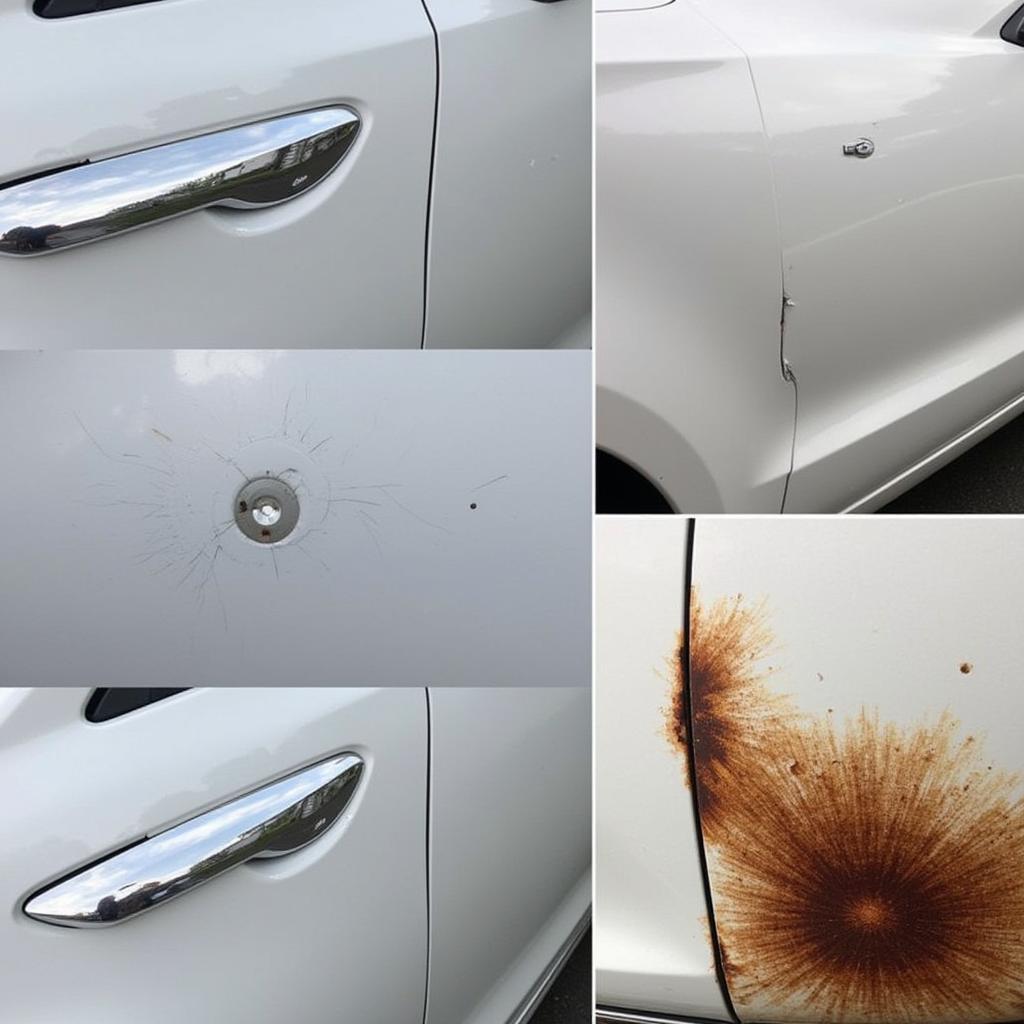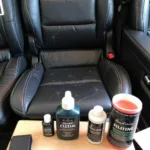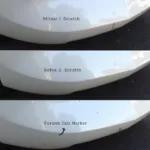Car body repair can seem daunting, but with the right knowledge and tools, even beginners can tackle minor repairs themselves. This comprehensive car body repair tutorial provides step-by-step guidance to help you restore your car’s appearance and save money in the process.
Assessing the Damage: Know Your Repair
Before diving into car body repair, it’s crucial to assess the damage accurately. Different repair methods are required for various types of damage, so identifying the specific issues your car faces is the first step.
Common Types of Car Body Damage:
- Scratches: Superficial damage affecting the clear coat or paint.
- Dents: Depressions in the metal body panels, with or without paint damage.
- Cracks: Linear fractures in the bodywork, often caused by impacts.
- Rust: Corrosion of the metal body panels, requiring prompt attention to prevent spreading.
Determining Repair Complexity:
Once you’ve identified the damage type, evaluate its severity:
- Minor Damage: Small scratches, shallow dents, and surface rust can often be addressed with DIY techniques.
- Major Damage: Deep dents, extensive cracks, structural damage, and severe rust usually require professional intervention.
Essential Tools for Car Body Repair: Equipping Yourself for Success
Having the right tools is crucial for successful car body repair. While the specific tools may vary depending on the repair, here are some essentials:
- Cleaning Supplies: Car wash soap, microfiber cloths, wax, and grease remover.
- Sanding Supplies: Sandpaper (various grits), sanding block, and tack cloth.
- Body Filler: For filling dents and imperfections.
- Putty Knife: To apply and smooth body filler.
- Masking Tape and Paper: To protect surrounding areas during painting.
- Primer, Paint, and Clear Coat: Matched to your car’s color code.
- Paint Brushes, Rollers, or Spray Gun: Depending on the repair size and your preference.
- Safety Gear: Gloves, safety glasses, and a respirator.
Step-by-Step Guide to Car Body Repair: From Prep to Finish
This section provides a general overview of the car body repair process. Remember to refer to specific tutorials for detailed instructions on addressing individual types of damage.
1. Preparation:
- Thoroughly wash and dry your car.
- Mask off the area surrounding the damage using masking tape and paper.
- Sand the damaged area to create a smooth surface for the repair.
2. Repair:
- Scratches: Use rubbing compound for light scratches, touch-up paint for deeper scratches, and clear coat to seal the repair.
- Dents: For minor dents, try paintless dent repair (PDR) using specialized tools. For larger dents, apply body filler, sand it smooth, and prime the area.
- Cracks: Clean the crack thoroughly, apply fiberglass or epoxy resin, and sand it down once dry.
3. Priming and Painting:
- Apply primer to bare metal or body filler.
- Once the primer dries, sand it smooth and clean the area.
- Apply several thin coats of paint, allowing each coat to dry completely.
4. Finishing Touches:
- Apply clear coat for a glossy finish and UV protection.
- Once the clear coat dries, use rubbing compound and polishing compound to achieve a professional shine.
- Remove the masking tape and paper.
Tips for a Professional Finish: Expert Insights
Achieving a professional-looking finish requires attention to detail and a few expert tips:
“Patience is key in car body repair. Rushing the process will lead to subpar results,” says John Smith, an experienced automotive technician. “Take your time, follow the steps carefully, and don’t be afraid to ask for help if needed.”
- Use thin coats: When applying primer, paint, or clear coat, multiple thin coats are always better than one thick coat. This helps prevent runs and ensures even coverage.
- Wet sanding: For a smoother finish, consider wet sanding between coats of paint and clear coat. Use fine-grit sandpaper and plenty of water to avoid damaging the paint.
- Proper lighting: Work in a well-lit area to ensure you can see any imperfections and achieve a consistent finish.
- Practice makes perfect: Don’t be discouraged if your first attempt isn’t flawless. Practice makes perfect, and each repair will improve your skills.
Conclusion
Car body repair can be a rewarding DIY project, allowing you to restore your car’s appearance and potentially save money on professional repairs. By following this comprehensive tutorial, equipping yourself with the right tools, and practicing patience and attention to detail, you can achieve impressive results. Remember to assess the damage carefully, choose the appropriate repair methods, and prioritize safety throughout the process.
FAQs: Common Questions About Car Body Repair
1. Can I repair rust myself?
Yes, minor surface rust can often be treated with a rust converter and touch-up paint. However, extensive rust requires professional attention.
2. What is paintless dent repair (PDR)?
PDR is a technique for removing minor dents without affecting the original paint. It involves using specialized tools to massage the metal back into its original shape.
3. How long does it take for car body repair to dry?
Drying times vary depending on the products used and environmental conditions. Always follow the manufacturer’s instructions for drying times.
4. Can I use a hairdryer to speed up the drying process?
It’s best to avoid using a hairdryer as excessive heat can damage the paint. Allow the repair to air dry or use a low-heat drying lamp if recommended.
5. How can I find my car’s paint color code?
The paint color code is usually located on a sticker inside the driver’s side door jamb, glove compartment, or owner’s manual.
Looking for more in-depth information on specific car body repair topics?
- Learn how to use a car body dent repair tool kit t puller.
- Explore different car body paintless dent repair tools dent puller options.
- Discover effective techniques for car body crack repair.
- Watch helpful car body dent repair youtube tutorials.
- Join a car body repair forum for expert advice and community support.
Need personalized assistance with your car body repair? Our team of car repair experts is just a message away. Contact us via WhatsApp: +1(641)206-8880 or Email: [email protected]. We’re available 24/7 to answer your questions and provide guidance on all your car repair needs.



